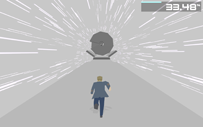
(03:19) And after about 20 years of this, he made the very bold proposal that pictures he had cooked up in his mind to explain the way things were working was actually the correct description of the universe that we live in. He did a couple of fairly important things like discover electromagnetic induction and invent the electric motor. He was getting magnets and wrapping copper wire around them. Over a period of about 25 years, he was playing with ideas of electricity and magnetism. That meant he really made one of the most important contributions to theoretical physics. And yet rather wonderfully, he built up this intuition for the way the universe works. Faraday was one of the great experimental physicists of all time, he was very much an experimental physicist, not a theorist. Tong (02:37): It all goes back to Michael Faraday.

What was his idea? And what did he discover? We’re going to be talking about fields today. I’ve enjoyed reading your lectures on the internet and watching some of your fantastic talks on YouTube. Strogatz: I’m thrilled to have a chance to talk to you. David, thank you so much for joining us today.ĭavid Tong (02:15): Hi, Steve. The Simons Foundation also funds this podcast. He’s also a Simons Investigator, an award from the Simons Foundation to scientists and mathematicians to study fundamental questions. Among his many honors, he was awarded the Adams Prize in 2008, one of the most prestigious awards that the University of Cambridge bestows.

His specialty is quantum field theory, and he’s also renowned as an exceptionally gifted teacher and expositor. David is a theoretical physicist at the University of Cambridge. (01:38) Joining me now to discuss all this is Professor David Tong. It seems to be mathematically incomplete, leaving us with many unanswered questions. Yet, there’s also reason to believe that quantum field theory is missing something. On top of that, quantum field theory has also been shedding enormous light on certain questions in pure mathematics, especially in the study of four-dimensional shapes and even higher dimensional spaces. In some cases, it makes predictions that agree with experiments to an astonishing 12 decimal places. The theory of quantum fields is arguably the most successful scientific theory of all time. They can even, some of them, flow right through us. These invisible fields sometimes act like particles, sometimes like waves. Instead, physicists tell us that at the deepest level, everything is made up of mysterious entities, fluid-like substances that we call quantum fields. (00:39) But today, we know that’s not really the case. These are the particles that have traditionally been considered to be the end of the line, the fundamental building blocks of matter.

Dig even deeper and pretty soon you’ll find yourself at the level of electrons and quarks. And cells, in turn, are made of molecules and molecules are made of atoms. Just like other living things, of course, we’re made of cells.

(00:12) If you’ve ever wondered what are we actually made of, you probably found yourself going down a rabbit hole of discoveries. Steven Strogatz (00:03): I’m Steve Strogatz, and this is The Joy of Why, a podcast from Quanta Magazine that takes you into some of the biggest unanswered questions in math and science today.


 0 kommentar(er)
0 kommentar(er)
